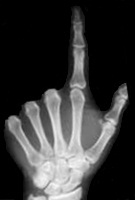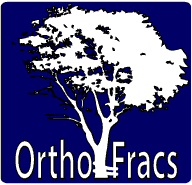Journal Club
March 2010
Two stage revision arthroplasty of the hip for infection using an interim articulated Prostalc hip spacer. A 10-15 year follow up study.
Biring et al
University of British Columbia, Vancouver, Canada
JBJS Br November 2009
No external funding or benefit recieved
Reviewed by
Dr Owen Mattern
MBBS | Unaccredited Orthopaedic Registrar
Introduction
- Deep infections after THR difficult to treat
- Number of options
- 1 stage
- 2 stage
- Articulated spacer - was used in this study
- Non-articulated spacer
- Time to second revision
Aims
- Primary
- Determine whether two-stage revision with Prostalac articulated hip spacer and other management principles were associated with eradication of infection
- Secondary
- Assess quality of life and satisfaction of patients
- Survivorship of the revised THR
Methodology
- Retrospective cohort study
- Level 4 evidence
- Approved by institutional review board
- Patients identified off database who had been treated with Prostalac spacer
- Nov 1989 - June 1996
- 103 patients
- 92 were followed up (44 deceased, 48 alive)
- Patients/NOK/medical records/GP’s contacted
- Information collected
- Recurrence of infection
- Undergone or awaiting further revision surgery
- Tests for suspected infection
- Quality of life measures were obtained
- WOMAC OA index
- Oxford-12
- SF-12
- UCLA activity scale
- Satisfaction questionnaire
- Charnley class of coomorbidity
Operative Technique
- Prostalac system (Depuy, Warsaw Id)
- Acetabular component
- Triflanged poly cup contrained to femoral head
- Antibiotic laden cement
- Femoral component
- Standard and long stem within a sleeve of antibiotic laden cement
- Pressfit to achieve vertical and torsional stability
- Acetabular component
- Combination of Abx used in cement
- No drains
Post OT
- PWB
- IVABx for 6/52
- Hip aspiration at 10/52
- Second stage revision mean 5 months (1-36)
- Prostalac removed “usually with ease”
- IVAbx until final intraoperative cultures available
Approach
- Lateral - 51 patients
- Trochanteric osteotomy - 30 patients
- Posterior - 17 patients
- MacFarland-Osborne approach - 1 pt
- 19 required extended trochanteric osteotomies
Prosthesis
- Femoral
- 14 proximal femoral replacements
- 4 allograft prosthesis composites
- 62 cemented
- 19 uncemented
- Acetabulum
- 91 uncemented
- 5 bipolar
- 3 cemented
Statistics
- No discussion regarding statistical analysis used
Results
- 103 patients
- 4 had only 1 stage performed - excluded
- Indication
- 92 prosthetic infection
- 5 sepsis native hip
- 2 infected ORIF proximal femur
- 92 were followed up
- 7 lost to follow-up
- 2 infections (included in results)
- 92 patients
- 44 died, 48 were alive
- Mean f/u 12 years (10-15years)
- 7 lost to follow-up
| Organism | Number |
| Staph Epi (9 MRSE) | 22 |
| Staph Aur (1 MRSA) | 22 |
| Multiple Organims (Staph/strep) | 20 |
| Strep Species | 12 |
| Other Gram negative | 10 |
| Other Staph species | 4 |
| E-Coli | 3 |
| Mycobacterium tuberculosis | 1 |
| No Organism | 5 |
Abx in cement
- Vancomycin/tobramycin - 86 patients
- Tobramycin/Pen G - 6 patients
- Tobramycin - 3 patients
- Vancomycin/Pen G - 2 patients
- Streptomycin - 1 pt
- Ceftizoxime - 1 pt
11 reinfections (included 2 lost to follow-up)
- 89% eradication rate
- 7 responded to subsequent surgery
- 2 resection arthroplasties
- 1 hip disarticulation
- 1 sinus and suppressive Abx
Further operation in 9 - not related to infection
- 4 aseptic loosening - 3 both, 1 acetabulum
- 2 dislocators
- 1 dislocator and periprosthetic #
- 1 periprosthetic fracture
- 1 removal of cable and claw
Quality of Life Outcomes
- 38/48 patients completed data
- Not well documented
- Similar Charnley class
- Only comment that outcomes are similar to other revision patients
- Good WOMAC score
- Below average physical scores - Oxford, SF12
- Average mental score
- High satisfaction score - 90.5%
- Mild activity level - limited housework, shopping and walking
Discussion
- Successful long-term eradication
- Out to 10 years
- Comparable to other 2 stage revision publications
Pros of Study
- Long-term follow-up of large group of patients
- Well operative and post-operative regime
- Included details regarding re-operation for all causes
Cons of Study
- Poor detail regarding quality of life measures and results
- Oxford 12 score is out of either 48 or 60
- They gave score as being 74
- Do not explain satisfaction score
- High mortality rate
Take home message
Two stage revision using a Prostalac spacer and antibiotic cement can achieve high eradication rate over the long-term
Webpage Last Modified:
24 May, 2010



